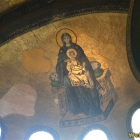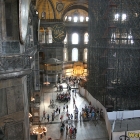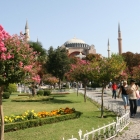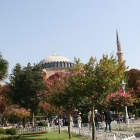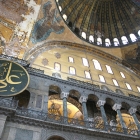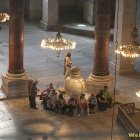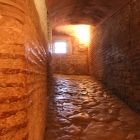Hagia Sophia, the Byzantine response to the Temple of Solomon
The legend has it that when he first entered his masterpiece, emperor Justinian lift his eyes towards the dome and uttered: “Oh, Solomon, I’ve surpassed you!”. To understand just how entitled this far from modest remark was, we must put our imagination to work, picturing the basilica painted, the marble floor, the precious stones, the golden dome and the silver iconostasis, priests’ vestments and the chorus singing Gregorian hymns from the circular balcony. As in the first centuries, the believers used to sing along the whole liturgy, for the thousands that could enter Hagia Sophia at one time, this must have been not a show, but a mystical experience. There are known cases of famous visitors that converted after witnessing a ceremony here, in the largest church of the Christian world. Others were content to declare it the eighth wonder of the world.
So step carefully, this is not just another cathedral. It is the heart of Orthodoxy and the prototype for all churches in the East. It has the grandeur of a western cathedral, but its purpose was to allow the Grace to descent upon believers, being the essence of what the Byzantine empire was: a city of God, an empire ran by emperors who are now in the Christian calendars, an empire that sanctified wisdom.
Holy Wisdom, is a name that marked the destiny of this building. Both the Muslim Ottomans, who conquered Constantinople and turned it into a mosque, keeping it in one piece, and the Turks from the time of Mustafa Kemal Ataturk, that turned it into a museum, treated Hagia Sophia wisely. It is a little Jerusalem, accepted as sacred place by Christians and Muslims alike and admired by art lovers.
The various names under which it was known speak of the turbulent times it passed: Sancta Sophia in Latin, Hagia Sophia, Agia Sofia in Greek, or, after the local pronunciation, Ayasofya. But it is not dedicated to a saint named Sophia, this being the shorten name from “The Church of the Holy Wisdom of God”.
As in the case of the great pyramid of Cheops, speculations appeared on the perfect proportions of this iconic building. The supposed perfection is obtained by superimposing a circle to a square, with the square tips on another circle. For centuries it was a mystery for scientists how its designers, the physicist Isidore of Milletus and the mathematician Anthemios of Tralles managed to sustain the 56 m high dome, 31 m wide, only on the walls of the church. Over 10.000 workers toiled for the job.
The shape also has something to do with the Ptolemaic view of the universe: a square (a cube), representing the Earth, with its cardinal points, and above a circle (half of a sphere), representing the sky and divinity. What’s amazing is that at the moment you step inside through the Emperor’s gate, you only see the vault, and not the four pendentives supporting it. When the fresco was intact, in the center of the dome stood (like in most Orthodox churches) the icon of Jesus Christ Pantokrator (Almighty).
Most probably, on the same spot, near the Bosphorus and the Golden Horn, stood a Greek temple and then two Christian churches, destroyed by fires. Hagia Sophia was erected in only five years, between 532 and 537. The first dome collapsed only decades after inauguration during an earthquake, so it was replaced by a dome that only lasted five years. Finally, the nephew of Isidore found the right proportion, raising the walls a bit. This dome was destroyed and rebuilt only in the 16th century by the Ottoman architect Mimar Sinan (Sina the Architect) who added some support elements together with new minarets that can be seen today. On the east side and west side there are half of domes arching to define the elegant shape of the building. The weight of the dome is take by the pendentives – triancles with one tip down and rounded upper side, that make the transition from the dome to the walls. Marble columns, golden mosaics, white and purple porphyry were embellishing the church on the inside.
A thousand years after Justinian, Hagia Sophia remained the largest cathedral on earth, until the cathedral of Seville.
The most valuable surviving peace of mosaic is the one depicting Jesus Christ, with Virgin Mary on one side and John the Baptist on the other, dating from the 13th century. The mosaic marked the return to the Orthodox rite after a Latin occupation during which the church was used by Pope’s subjects. The quality of representation in this mosaic is similar to the one of a Renaissance painting, but with all the prescriptions of an Orthodox painting. In another mosaic, emperor Constantine presents the model of his city to the Virgin Mary and Justinian presents a model of his cathedral.
We don’t know whether the giant image of Jesus Christ Pantokrator on the dome could be brought to light, from underneath the Arab calligraphy that now covers it, the topic being a delicate one in today’s Turkey. While that image still remains hidden, above the altar we can see a splendid mosaic representing the Virgin Mary with Child. It is probably a restoration of the 9th century work, destroyed during the iconoclast era, keeping the golden background that amazed any visitor. For the Orthodox icons, the gold foil on the aura of saints or on the background of an icon signifies the divine light and holiness.
The round balcony at the first floor is interrupted above the altar, that had a silver iconostasis of 15 m height. On the side walls there are fragments of depictions of archangels Michael and Gabriel, the angel of Annunciation. The angelic motive is present everywhere in Hagia Sophia, in the upper corners, where are painted giant angel wings, while the chorus at the first floor were said to imitate the chorus of angels.
Some historic events have happened here, as coronations and ecumenical councils. To get to the top floor, where the imperial throne stood, you go through a stone tunnel that reminds the early age of Christianity, when the forbidden religion survived in catacombs.
The statues and paintings were destroyed before the Ottoman invasion, in the 8th century, during the iconoclast period. But unfortunately, iconoclasts were not the only “Christians” to damage the church in Istanbul. Crusaders, coming from the West (France and Venice) desecrated and sacked it at the passing from 12th and 13th century. These so called defenders of Christianity in front of Islam turned to an unseen terror, with rapes in the city and crimes against priests. In the church of Holy Wisdom, the crusaders destroyed the iconostasis, the icons and even enacted a profanitory spectacle based on the prophecies of the Revelation, putting a prostitute on the bishop’s throne, to drink from the holy grail. After the pope distanced him from the deeds of his subjects, the crusaders, Hagia Sofia was turned into a catholic church in the decades of Latin rule over Constantinople.
In the two centuries until the fall of the city to the Ottomans, Hagia Sophia degraded, becoming a ruin. Its transformation into a mosque after 1453 was even more dramatic. For this to be done, sultan Mohamed II took some measures: he brought down the cross from the top of the church, covered all icons in plaster (as the Muslim faith does not allow divine, human or animal depiction in fear of idolatry) added the minarets (the towers from which the muezzin calls to prayer), and instead of the iconostasis erected a minbar (the Muslim pulpit from which the imam reads the ceremonial text). As the neighboring Blue Mosque testifies, Hagia Sophia greatly influenced Islamic architecture. To this day, almost all mosques around the world emulate the aspect of this former Christian church.
We must underline the wisdom of the Ottoman sultans, who ordered that from time to time the mosaics to be brought to light, restored and again covered. This can be explained by the fact that the main characters of the Bible are also found in Qur’an, so the Turks would not consider committing profanities against those depictions. Christians like to consider a miracle the fact that the sign of the cross has simply emerged from underneath the plaster, although other mosaics have been lost.
Sultan Bayezid II also built a minaret and Suleiman the Magnificent brought the Hungarian chandeliers as war prey. Mahmud I extended the mosque, turning it into an Islamic cultural complex, with school, canteen for the poor, library and fountain for the ritual bath before prayer. Just as careful with Hagia Sophia was sultan Abdulmecid, as this was for a very long time the largest mosque in the world.
The mosque was turned into a museum in 1934 under Mustafa Kemal Ataturk and the fragments of mosaic that could be saved were revealed. The inscriptions from Qur’an were also left in place, as the Ottoman decorations. The carpets were taken out, leaving the marble floor, so Aya Sofya is the only mosque where tourists don’t have to take their shoes off. Instead, they have to pay for the ticket of 20 lira (about 10 euro), that allows you to take pictures of videos. Every year, one to two million tourists come to see this eighth wonder of the world still undergoing restoration.
- Home Page
start page - Architecture
landmark buildings - Sacred architecture
places of worship - Nature
landscape photography - Concert
performing artists - Christmas
Santa Claus pictures
- Jooble
jobs for photographers - Escape
an out of control blog - Merry Christmas
The best organizer of Christmas parties - Astro photo
Eclipse hunting and astrological photography

